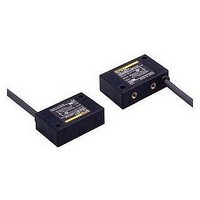TL-T2E15 Omron, TL-T2E15 Datasheet - Page 11

TL-T2E15
Manufacturer Part Number
TL-T2E15
Description
Inductive Proximity Sensor
Manufacturer
Omron
Series
TL-Tr
Specifications of TL-T2E15
Sensor Input
Inductive
Sensing Range
2mm
Supply Voltage Range Dc
10V To 30V
Sensing Range Max
2mm
Sensor Housing
Rectangular
Switch Terminals
Cable
Sensor Output
NPN Voltage-Current Output
Sensing Distance
0.079" (2mm)
Sensor Type
Inductive
Sensing Object
Metallic
Response Frequency
800Hz
Material - Body
ABS Resin
Shielding
Shielded
Voltage - Supply
10 V ~ 30 V
Output Type
NPN-NO
Terminal Type
3-Wire
Package / Case
Box
Lead Free Status / RoHS Status
Lead free / RoHS Compliant
●Wiring Considerations
AND/OR Connections for Proximity Sensors
Note: When AND/OR connections are used with Proximity Sensors, the effects of erroneous pulses or leakage current may prevent use. Verify that there are no
DC 2-Wire
AC 2-wire
Model
problems before use.
connection
AND (series
connection)
OR (parallel
connection)
AND (series
connection)
OR (parallel
connection)
Type of
http://www.ia.omron.com/
(A)
(A)
+
+
-
+
X
-
1
-
+
(B)
(B)
Connection
X
1
Load
Load
Load
X
V
X
L
2
2
Load
X
Load
Load
Load
1
X
X
X
2
1
2
V
Vs
Vs
S
V
V
V
Proximity Sensors Technical Guide
≥ 100V
S
S
S
Keep the number of connected Sensors (N) within the range of the following
equation.
V
It is possible, however, that the indicators may not light correctly and error
pulses (of approximately 1 ms) may be generated because the rated power
supply voltage and current are not supplied to individual Proximity Sensors.
Verify that this is not a problem before operation.
Keep the number of connected Sensors (N) within the range of the following
equation.
N × i ≤ Load reset current
Example: When an MY (24-VDC) Relay is used as the load, the maximum
number of Sensors that can be connected is 4.
<TL-NY, TL-MY, E2K-@MY@, TL-T@Y>
The above Proximity Sensors cannot be used in a series connection. If need-
ed, connect through relays.
<E2E-X@Y>
For the above Proximity Sensors, the voltage VL that can be applied to the
load when ON is V
both 100 VAC and 200 VAC.
The load will not operate unless V
This must be verified before use.
When using two or more Sensors in series with an AND circuit, the limit is three
Sensors. (Be careful of the VS value in the diagram at left.)
In general it is not possible to use two or more Proximity Sensors in parallel
with an OR circuit.
A parallel connection can be used if A and B will not be operated simulta-
neously and there is no need to hold the load. The leakage current, however,
will be n times the value for each Sensor and reset failures will frequently oc-
cur.
("n" is the number of Proximity Sensors.)
If A and B will be operated simultaneously and the load is held, a parallel con-
nection is not possible.
If A and B operate simultaneously and the load is held, the voltages of both A
and B will fall to about 10 V when A turns ON, and the load current will flow
through A causing random operation. When the sensing object approaches B,
the voltage of both terminals of B is too low at 10 V and the switching element
of B will not operate. When A turns OFF again, the voltages of both A and B
rise to the power supply voltage and B is finally able to turn ON.
During this period, there are times when A and B both turn OFF (approximately
10 ms) and the loads are momentarily restored. In cases where the load is to
be held in this way, use a relay as shown in the diagram at left.
S
N : Number of Sensors that can be connected
V
V
N: Number of Sensors that can be connected
i: Leakage current of Proximity Sensor
- N × V
R
S
: Power voltage
: Residual output voltage of Proximity Sensor
(c)Copyright OMRON Corporation 2008 All Rights Reserved.
R
≥ Operating load voltage
L
= V
S
- (Output residual voltage × Number of Sensors), for
Description
L
is higher than the load operating voltage.
C-6










